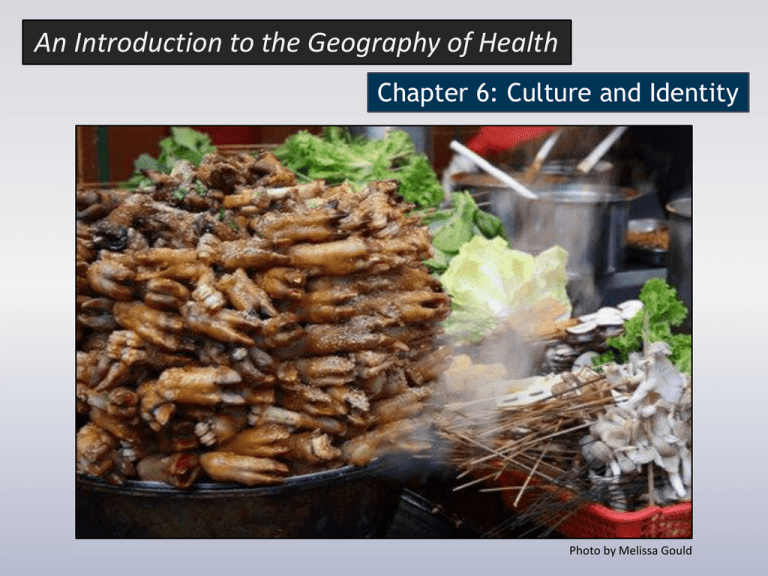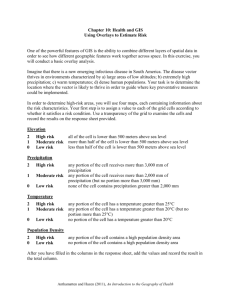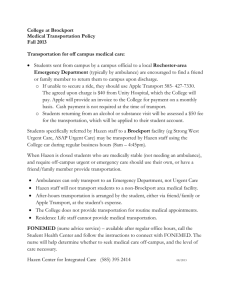
An Introduction to the Geography of Health
Chapter 6: Culture and Identity
Photo by Melissa Gould
Health and Culture
Culture refers to the beliefs and practices
acquired from society that are lived by a
particular group of people.
Gesler and Kearns (2002: 13) warn, “culture
should not be used as a source of explanation;
rather it is something to be explained as it is
continually being socially produced by people as
they struggle to achieve power and meaning.”
What do Gesler and Kearns mean when they write
that culture is “continually being socially produced”?
Can you provide an example?
Can you think of an example of how health
and culture are related in your life?
2
Anthamatten and Hazen
An Introduction to the Geography of Health
Chapter 6
Health geographers focus on both how culture
influences health and how health influences culture.
Culture may influence health via health policies, social
norms, or even cultural understandings of what
constitutes health or disease.
For example, different
governments have issued different
guidelines about diet for women
during pregnancy.
3
Anthamatten and Hazen
What guidelines are you aware of
regarding diet during pregnancy?
Where do you think you learned this
information?
An Introduction to the Geography of Health
Chapter 6
Government-issued Pregnancy Recommendations
France
Avoid: soft cheeses with white rind (e.g., Brie),
especially if made with raw milk; industriallygrated cheese; cheese rinds; cooked pork;
potted meat, pâté, foie gras, and gelatinous
products; raw or rare meat; raw fish and
shellfish; smoked fish; alcohol; liver
Consume in moderation: caffeine, carbonated
drinks and energy drinks; soy-based foods
Source: Program National
Nutrition Santé (2007)
United States:
Avoid: alcohol; certain
types of fish
Hong Kong
Avoid: foods high in calories but
low in nutritional value such as
soft drinks
Consume in moderation: salty and
preserved foods; strong spices
such as chili
Consume in moderation:
certain types of fish
Source: Government of Hong Kong
Department of Health (2004)
US Department of Health and
Human Services (2006)
4
Anthamatten and Hazen
An Introduction to the Geography of Health
Chapter 6
Perceptions of what is considered to be
disease can be rooted in culture.
For example, many behavioral disorders are
dependent on an understanding of “normal”
behavior, which may have a different meaning
in different societies.
How would you define “disease”?
How does your definition compare to
others in the room?
5
Anthamatten and Hazen
An Introduction to the Geography of Health
Chapter 6
ADHD Diagnoses by State, 2007
Data Source: CDC 2007
6
Anthamatten and Hazen
In the case of ADHD, a rapid increase in diagnoses
in the 1990s and regional differences in incidence
rates have led some to suggest that the diagnosis
of ADHD may be influenced by culture.
An Introduction to the Geography of Health
Chapter 6
Sometimes cultural
conceptualization of health
are highly contentious.
The surgical removal of
female genital parts is
considered inhumane in
many parts of the world, yet
is common practice in some
communities in Africa.
This map shows the
percentage of girls who
receive a clitoridectomy—one
form of genital cutting.
Data from Yoder et al. (2004)
7
Anthamatten and Hazen
An Introduction to the Geography of Health
Chapter 6
Cultural beliefs can also contradict biomedical
practice. In the West, for example, there has recently
been a backlash against vaccination programs,
related to concerns over the safety of vaccines.
Should practices such as clitoridectomy be banned
or vaccination programs be required?
Who should make decisions like this?
8
Anthamatten and Hazen
An Introduction to the Geography of Health
Chapter 6
Health and Identity
Important aspects of identity include gender, class, race,
ethnicity, and sexuality, with people’s identities evolving out
of a complex layering of these factors.
Facets of identity intersect with culture to produce
expectations and behaviors that affect health.
How do you think your identity
might have affected your health?
Photo by Helen Hazen
9
Anthamatten and Hazen
Incan symbols and clothing
remain important for this
community in Andean Peru.
An Introduction to the Geography of Health
Chapter 6
Sometimes the health impacts of social identities can be
measured. For instance, African American women are more
likely to have low birth weight babies than are mothers from
white or African-born populations in the US.
This graph shows the birth
weight distributions of three
populations in Illinois.
How could racial and
ethnic identity play a
role in birth weight?
10
Anthamatten and Hazen
Source: David and Collins (1997)
Copyright © [1997] Massachusetts Medical Society. All rights reserved.
An Introduction to the Geography of Health
Chapter 6
Gender
Although biological distinctions may appear to be
the main difference between men and women,
social theorists have argued that much of what gives
women and men different experiences is how
masculinity and femininity are socially constructed.
In this context, there is an important distinction
between sex (the biological reality of being
male or female) and gender (the sociallyconstructed aspects of being male or female).
How could social constructions of
gender influence health?
11
Anthamatten and Hazen
An Introduction to the Geography of Health
Chapter 6
The notion of structural violence is used to refer to
the ways in which social structures and institutions
prevent people from meeting their basic health
needs, and is often considered to be gendered.
For example, women are more likely than men
to be the victims of sexual violence. In some
places, women and girls may be less likely to
receive healthcare when they are sick.
12
Anthamatten and Hazen
An Introduction to the Geography of Health
Chapter 6
Race
Traditionally, studies of the influence of race on
health have focused on seeking genetic differences
among racial groups. These studies have typically
identified few genetic distinctions among races.
More recently, studies have focused on how the impact
of race on health is frequently confounded by
socioeconomic status.
Researchers have also begun to investigate the ways in
which race-based identities may have health implications.
How might a person’s ethnic or racial
identity have an impact on their health?
13
Anthamatten and Hazen
An Introduction to the Geography of Health
Chapter 6
Life-worlds
Some scholars have argued that the key to understanding these
geographies of difference is to appreciate the lived experiences
of individuals, rather than groups of people.
This perspective suggests that individual “life-worlds”—the sum
of one’s lived experiences—are important in understanding the
uniqueness of health outcomes and responses to them.
14
Anthamatten and Hazen
An Introduction to the Geography of Health
Chapter 6
Photos by Helen Hazen
How do you think the life-worlds of these people differ?
How could these differences influence their health?
15
Anthamatten and Hazen
An Introduction to the Geography of Health
Chapter 6
Identity and Disability
As identity can influence health, so too can health
influence identity. In particular, ill-health can act as a
significant facet of an individual’s identity.
What diseases or conditions can you think of
where individuals may actively seek, or avoid,
being labeled as having the disease?
16
Anthamatten and Hazen
An Introduction to the Geography of Health
Chapter 6
Geographies of Disability
Geographies of disability consider how the bodily and
social experiences of people with disabilities are unique.
Social and spatial exclusions are a particular focus.
Source: NPS 2006
17
Anthamatten and Hazen
An Introduction to the Geography of Health
Chapter 6
Conclusion
Culture and identity are powerful influences on our everyday
lives—this influence extends to the realm of health.
Our beliefs about ourselves and others and about our
relative positions in society are integral to our health, how
we think about improving it, and how we perceive people
who are not in good health.
18
Anthamatten and Hazen
An Introduction to the Geography of Health
Chapter 6
Discussion Questions
1. How is health defined differently by different cultural or social
groups? How would you define “health”?
2. Treichler (1999: 11) argues that “the AIDS epidemic…is
simultaneously an epidemic of a transmissible lethal disease and an
epidemic of meanings or signification.” In what ways have these
signifiers led to discrimination and stigma? What other diseases show
strong evidence of the influence of socially-constructed meaning?
3. Cultural practices are often viewed as distinct from other human
actions as somehow inalienable. How can we define a cultural practice?
Should groups be allowed to continue cultural practices even if they are
detrimental to health?
19
Anthamatten and Hazen
An Introduction to the Geography of Health
Chapter 6
Discussion Questions
4. Are there specific ways that healthcare services or public health
initiatives could be more sensitive to the identities and cultural
contexts of minority groups? Can you think of examples of policies or
programs that are insensitive to issues of culture or identity?
5. Is the distinction between “disability” and “impairment” a significant
one? Why or why not? How might characteristics of an individual’s
environment be significant in turning an impairment into a disability?
20
Anthamatten and Hazen
An Introduction to the Geography of Health
Chapter 6
References
[CDC] Centers for Disease Control. (2007) State-based Prevalence Data of ADHD Diagnosis [Online]. Available: <
http://www.cdc.gov/ncbddd/adhd/prevalence.html > (Accessed 01 January 2011).
Gesler, W. M. and Kearns, R. A. (2002) Culture, Place, and Health, London; New York: Routledge.
Government of Hong Kong, Department of Health. (2004) Nutrition for Pregnant Women and Breastfeeding Mothers
[Online]. Available: <http://www.fhs.gov.hk/english/health_info/files/an_5.pdf> (Accessed 27 April 2010).
[NPS]. National Park Service. (206). Map Symbols & Patterns for NPS Maps [Online]. Available:
<http://www.nps.gov/hfc/carto/map-symbols.htm> (Accessed 13 January 2011).
New Zealand Ministry of Health. (2008) Eating for Healthy Pregnant Women [Online]. Available:
<http://www.healthed.govt.nz/uploads/docs/HE1805.pdf> (Accessed 27 April 2010).
Program National Nutrition Santé. (2007) Le guide nutrition pendant et après la grossesse [Online]. Available:
<http://www.mangerbouger.fr/IMG/pdf/grossesse.pdf> (Accessed 12 May 2010).
Treichler, P. A. (1999) How to Have Theory in an Epidemic: Cultural Chronicles of AIDS, Durham: Duke University Press.
US Department of Health and Human Services. (206) What to Eat While Pregnant [Online]. Available:
<http://www.womenshealth.gov/pregnancy/pregnancy/eat.cfm> (Accessed 27 April 2010).
21
Anthamatten and Hazen
An Introduction to the Geography of Health
Chapter 6






